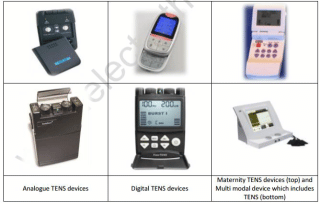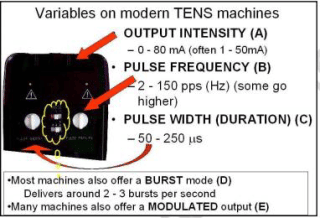Everything you need to know about your TENs Machine.
You may have had TENs as a form of treatment in your past, heard of the treatment or even have a TENs machine at home to use for your condition.
BUT, do you know what a TENs Machine actually does? How it works? Are you getting the most benefits out of the treatment? In this article, I’ll explain everything you as a patient need to know about TENs Treatment so you are confident in knowing how to properly use the machine at home (if you have one) or you are educated on how it can help you and your condition clinically.
What is a TENs Machine?

TENS as a treatment technique is non invasive and has few side effects when compared with drug therapy.
***A TENS MACHINES PRIMARY GOAL IS PAIN RELIEF***
How does a TENS achieve pain relief?
FREQUENCY (B): The machine will deliver discrete ‘pulses’ of electrical energy, and the rate of delivery of these pulses (the PULSE RATE or FREQUENCY (B) will normally be variable from about 1 or 2 pulses per second (pps) up to 200 or 250 pps (sometimes the term Hertz or Hz is used here). To be clinically effective, it is suggested that the TENS machine should cover a range from about 2 – 150 pps (or Hz).
DURATION (C): In addition to the stimulation rate, the DURATION (OR WIDTH) OF EACH PULSE (C) may be varied from about 40 to 250 micro seconds. (a micro second is a millionth of a second). Recent evidence would suggest that this is possibly a less important control that the intensity or the frequency and the most effective setting in the clinical environment is probably around 200’s. The reason that such short duration pulses can be used to achieve these effects is that the targets are the sensory nerves which tend to have relatively low thresholds ( i.e. they are quite easy to excite) and that they will respond to a rapid change of electrical state. There is generally no need to apply a prolonged pulse in order to force a sensory nerve to depolarise, therefore stimulation for less than a millisecond is sufficient.
BURST MODE (D): In addition, most modern machines will offer a BURST MODE (D) in which the pulses will be allowed out in bursts or ‘trains’, usually at a rate of 2 – 3 bursts per second.
MODULATION MODE (E): may be available which employs a method of making the pulse output less regular and therefore minimizing the accommodation effects which are often encountered with this type of stimulation. Both the burst and modulation modes will be discussed in more detail in the following sections.
MECHANISM OF ACTION
The type of stimulation delivered by the TENS unit aims to excite (stimulate) the sensory nerves, and by so doing, activate specific natural pain relief mechanisms. For convenience, if one considers that there are two primary pain relief mechanisms which can be activated :
The Pain Gate Mechanism and the Endogenous Opioid System, the variation in stimulation parameters used to activate these two systems will be briefly considered.
Pain relief by means of the pain gate mechanism involves activation (excitation) of the A beta (A?) sensory fibres, and by doing so, reduces the transmission of the noxious stimulus from the ‘c’ fibres, through the spinal cord and hence on to the higher centres. The A? fibres appear to appreciate being stimulated at a relatively high rate (in the order of 80 – 130 Hz or pps).
An alternative approach is to stimulate the A delta (A?) fibres which respond preferentially to a much lower rate of stimulation (in the order of 2 – 5 Hz, though some authors consider a wider range of 2 – 10Hz), which will activate the opioid mechanisms, and provide pain relief by causing the release of an endogenous opiate (encephalin) in the spinal cord which will reduce the activation of the noxious sensory pathways.
A third possibility is to stimulate both nerve types at the same time by employing a burst mode stimulation. In this instance, the higher frequency stimulation output (typically at about 100Hz) is interrupted (or burst) at the rate of about 2 – 3 bursts per second. When the machine is ‘on’, it will deliver pulses at the 100Hz rate, thereby activating the A? fibres and the pain gate mechanism,
For some patients this is by far the most effective approach to pain relief, though as a sensation, numerous patients find it less acceptable than some other forms of TENS as there is more of a ‘grabbing’, ‘clawing’ type sensation and usually more by way of muscle twitching than with the high or low frequency modes.
TRADITIONAL TENS MACHINE
Usually uses stimulation at a relatively high frequency (80 – 130Hz) and employ a relatively narrow (short duration) pulses though as mentioned above, there is less support for manipulation of the pulse width in the current research literature.
Most patients seem to find best effect at around 200s. The stimulation is delivered at ‘normal’ intensity – definitely there but not uncomfortable. 30 minutes is probably the minimal effective time, but it can be delivered for as long as needed. The main pain relief is achieved during the stimulation, with a limited ‘carry over’ effect – i.e. pain relief after the machine has been switched off.
FREQUENCY SELECTION : with all of the above mode guides, it is probably inappropriate to identify very specific frequencies that need to be applied to achieve a particular effect. If there was a single frequency that worked for everybody, it would be much easier, but the research does not support this concept. Patients (or the therapist) need to identify the most effective frequency for their pain, and manipulation of the stimulation frequency dial or button is the best way to achieve this.
-
-
- Acute pain is usually most effective between 80 and 120 Hz.
- Chronic pain can also benefit from lower settings 2 to 10Hz that stimulates an endorphin release.
- A setting between 35 and 50Hz is commonly used to stimulate muscles for strengthening or even relaxation.
-
STIMULATION INTENSITY : As identified above, it is not possible to describe treatment current strength in terms of how many microamps. The most effective intensity management appears to be related to what the patient feels during the stimulation, and this may vary from session to session.
As a general guide, it appears to be effective to go for a ‘definitely there but not painful’ level for the normal (high) TENS. There is a growing body of evidence that suggests that a ‘strong’ sensation, whichever mode is being used, might achieve better clinical effects.
ELECTRODE PLACEMENT : In order to get the maximal benefit from the modality, target the stimulus at the appropriate spinal cord level (appropriate to the pain). Placing the electrodes either side of the lesion – or pain areas, is the most common mechanism employed to achieve this. There are many alternatives that have been researched and found to be effective – most of which are based on the appropriate nerve root level :
-
-
- Stimulation of appropriate nerve root(s)
- Stimulate the peripheral nerve (best if proximal to the pain area)
- Stimulate motor point (innervated by the same root level)
- No Sensation
- Just Sensation
- Definite Sensation
- Strong Sensation
- Painful
- Stimulate trigger point(s) or acupuncture point(s)
- Stimulate the appropriate dermatome, myotome or sclerotome
-
Summary
TENs is a great modality to incorporate to achieve pain relief for both acute and chronic conditions – When used appropriately. Although the primary goal of the treatment itself is not to cure or fix the condition, it’s mechanism of action to achieve pain relief will indirectly help you manage your condition or aid in the correction causing the painful stimuli. When there is less pain – you will be able to do more of your exercises and enjoy your daily routine better.
For chronic pain, there is a strong correlation in how the brain perceives the painful area. A lot of the time, the brain believes there is still an issue going on in the area and sends a painful response – even if the initial injury has resolved. Using a TENs at home is a great way to help retrain the psychosomatic system of the brain to help it shut off the painful sensory receptors.
If you are unsure if your TENs Machine is set up appropriately for your condition to achieve the maximum benefit, please let us know and we would be glad to set it up correctly for you.
If you do not have a TENs Machine for home use and you believe it may help you and your condition(s) please let us know! We would be happy to have that discussion with you and let you know if we believe a TENs Machine would be a great option for you and your condition. If you have extended health insurance and we believe a TENs should be used at home for your condition, we will help/ guide you through the entire process of getting reimbursed.



